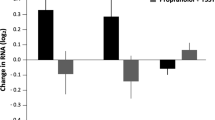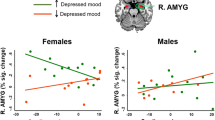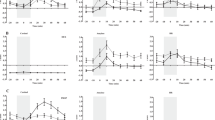Abstract
The glucocorticoid component of the stress response has been the subject of intense scientific scrutiny because of the wide ranging pathological consequences resulting from excess glucocorticoid exposure, including mood and anxiety disorders, and cognitive impairment. Exposure to stress activates the hypothalamic-pituitary-adrenal (HPA) axis and the sympathetic adrenomedullary system, which are regulated by neuronal pathways, including the inhibitory GABAergic (γ-aminobutyric acid) system. Approximately 60% of the variance in glucocorticod levels may be attributable to genetic individual differences. In the present study, 56 healthy subjects underwent genotyping to determine the influence of the T1521C single nucleotide polymorphism (SNP) in the GABAAα6 receptor subunit gene (GABRA6) on the hormonal and autonomic responses to psychological stress induced by the Trier Social Stress Test (TSST). Adrenocorticotropin (ACTH), cortisol, diastolic blood pressure, and mean blood pressure responses to the TSST were significantly greater in subjects homozygous for the T allele or heterozygous compared to subjects homozygous for the C allele. Behavioral data was collected employing the Revised NEO Personality Inventory (NEO PI-R); subjects homozygous for the C allele scored significantly lower on the Extraversion factor compared to subjects homozygous for the T allele or heterozygous. These results suggest that the T1521C polymorphism in the GABRA6 gene is associated with specific personality characteristics as well as a marked attenuation in hormonal and blood pressure responses to psychological stress.
This is a preview of subscription content, access via your institution
Access options
Subscribe to this journal
Receive 12 print issues and online access
$259.00 per year
only $21.58 per issue
Buy this article
- Purchase on Springer Link
- Instant access to full article PDF
Prices may be subject to local taxes which are calculated during checkout




Similar content being viewed by others
References
Miller DB, O’Callaghan JP . Neuroendocrine aspects of the response to stress. Metabolism 2002; 51: 5–10.
Sterling P, Eyer J . Allostasis: A new paradigm to explain arousal pathology. In: Fisher S, Reason J (eds). Handbook of Life Stress, Cognition and Health. John Wiley & Sons: New York, 1988 pp 629–649.
Bartels M, Van den Berg M, Sluyter F, Boomsma DI, de Geus EJ . Heritability of cortisol levels: review and simultaneous analysis of twin studies. Psychoneuroendocrinology 2003; 28: 121–137.
Sapolsky RM . Glucocorticoids and hippocampal atrophy in neuropsychiatric disorders. Arch Gen Psychiatry 2000; 57: 925–935.
Vanitallie TB . Stress: a risk factor for serious illness. Metabolism 2002; 51: 40–45.
Gold PW, Chrousos GP . Organization of the stress system and its dysregulation in melancholic and atypical depression: high vs low CRH/NE states. Mol Psychiatry 2002; 7: 254–275.
Sherwood Brown E, Varghese FP, McEwen BS . Association of depression with medical illness: does cortisol play a role? Biol Psychiatry 2004; 55: 1–9.
McEwen BS . Protective and damaging effects of stress mediators. N Engl J Med 1998; 338: 171–179.
Heuser I, Lammers CH . Stress and the brain. Neurobiol Aging 2003; 24: S69–S76, discussion S81–S82.
Tsigos C, Chrousos GP . Hypothalamic-pituitary-adrenal axis, neuroendocrine factors and stress. J Psychosom Res 2002; 53: 865–871.
De Kloet ER, Vreugdenhil E, Oitzl MS, Joels M . Brain corticosteroid receptor balance in health and disease. Endocr Rev 1998; 19: 269–301.
Jessop DS . Review: central non-glucocorticoid inhibitors of the hypothalamo-pituitary-adrenal axis. J Endocrinol 1999; 160: 169–180.
Chebib M, Johnston GA . The ‘ABC’ of GABA receptors: a brief review. Clin Exp Pharmacol Physiol 1999; 26: 937–940.
Farrant M . Amino acids: inhibitory. In: Webster R (ed). Neurotransmitters, Drugs and Brain Function. John Wiley & Sons: New York, 2001 pp 225–250.
Hicks AA, Bailey MES, Riley BP, Kamphuis W, Siciliano MJ, Johnson KJ et al. Further evidence for clustering of human GABAA receptor subunit genes: localization of the 6-subunit gene (GABRA6) to distal chromosome 5q by linkage analysis. Genomics 1994; 20: 285–288.
Loh EW, Smith I, Murray R, McLaughlin M, McNulty S, Ball D . Association between variants at the GABAAbeta2, GABAAalpha6 and GABAAgamma2 gene cluster and alcohol dependence in a Scottish population. Mol Psychiatry 1999; 4: 539–544.
Rosmond R, Bouchard C, Bjorntorp P . Allelic variants in the GABA(A)alpha6 receptor subunit gene (GABRA6) is associated with abdominal obesity and cortisol secretion. Int J Obes Relat Metab Disord 2002; 26: 938–941.
Dick DM, Foroud T . Candidate genes for alcohol dependence: a review of genetic evidence from human studies. Alcohol Clin Exp Res 2003; 27: 868–879.
Sen S, Villafuerte S, Nesse R, Stoltenberg SF, Hopcian J, Gleiberman L et al. Serotonin transporter and GABAA alpha 6 receptor variants are associated with neuroticism. Biol Psychiatry 2004; 55: 244–249.
Bucholz KK, Cadoret R, Cloninger CR, Dinwiddie SH, Hesselbrock VM, Nurnberger Jr JI et al. A new, semi-structured psychiatric interview for use in genetic linkage studies: a report on the reliability of the SSAGA. J Stud Alcohol 1994; 55: 149–158.
Kirschbaum C, Pirke KM, Hellhammer DH . The ‘Trier Social Stress Test’—a tool for investigating psychobiological stress responses in a laboratory setting. Neuropsychobiology 1993; 28: 76–81.
Beck AT, Steer RA, Brown GK . Manual for Beck Depression Inventory–II. The Psychological Corporation. Psychological Corporation: San Antonio, TX, 1996.
Costa Jr PT, McCrae RR . Revised NEO Personality Inventory: Professional Manual. Psychological Assessment Resources: Odessa, FL, 1992.
Costa Jr PT, McCrae RR . Normal personality assessment in clinical practice: the NEO Personality Inventory. Psychol Assess 1992; 4: 5–13.
Spielberger CD . Manual for the State-Trait Anxiety Inventory (Form Y). Consulting Psychologists Press: Palo Alto, CA, 1983.
Blevins Jr LS, Dobs AS, Wand GS . Naloxone-induced activation of the hypothalamic-pituitary-adrenal axis in suspected central adrenal insufficiency. Am J Med Sci 1994; 308: 167–170.
Liang KY, Zeger SL . Longitudinal data analysis using generalized linear models. Biometrika 1986; 73: 13–22.
Negrao AB, Deuster PA, Gold PW, Singh A, Chrousos GP . Individual reactivity and physiology of the stress response. Biomed Pharmacother 2000; 54: 122–128.
LocusLink. National Center for Biothechnology Information##http://www.ncbi.nih.gov.
Whiting PJ, Bonnert TP, McKernan RM, Farrar S, Le Bourdelles B, Heavens RP et al. Molecular and functional diversity of the expanding GABA-A receptor gene family. Ann N Y Acad Sci 1999; 868: 645–653.
Nutt DJ, Malizia AL . New insights into the role of the GABA(A)-benzodiazepine receptor in psychiatric disorder. Br J Psychiatry 2001; 179: 390–396.
Hsu YP, Seow SV, Loh EW, Wang YC, Chen CC, Yu JM et al. Search for mutations near the alternatively spliced 8-amino-acid exon in the GABAA receptor gamma 2 subunit gene and lack of allelic association with alcoholism among four aboriginal groups and Han Chinese in Taiwan. Brain Res Mol Brain Res 1998; 56: 284–286.
Loh EW, Higuchi S, Matsushita S, Murray R, Chen CK, Ball D . Association analysis of the GABA(A) receptor subunit genes cluster on 5q33–34 and alcohol dependence in a Japanese population. Mol Psychiatry 2000; 5: 301–307.
Sander T, Ball D, Murray R, Patel J, Samochowiec J, Winterer G et al. Association analysis of sequence variants of GABA(A) alpha6, beta2, and gamma2 gene cluster and alcohol dependence. Alcohol Clin Exp Res 1999; 23: 427–431.
Song J, Koller DL, Foroud T, Carr K, Zhao J, Rice J et al. Association of GABA(A) receptors and alcohol dependence and the effects of genetic imprinting. Am J Med Genet 2003; 117B: 39–45.
Parsian A, Cloninger CR . Human GABAA receptor alpha 1 and alpha 3 subunits genes and alcoholism. Alcohol Clin Exp Res 1997; 21: 430–433.
Edenberg HJ, Foroud T, Conneally PM, Sorbel JJ, Carr K, Crose C et al. Initial genomic scan of the NIMH genetics initiative bipolar pedigrees: chromosomes 3, 5, 15, 16, 17, and 22. Am J Med Genet 1997; 74: 238–246.
Yamada K, Watanabe A, Iwayama-Shigeno Y, Yoshikawa T . Evidence of association between gamma-aminobutyric acid type A receptor genes located on 5q34 and female patients with mood disorders. Neurosci Lett 2003; 349: 9–12.
Schuckit MA, Mazzanti C, Smith TL, Ahmed U, Radel M, Iwata N et al. Selective genotyping for the role of 5-HT2A, 5-HT2C, and GABA alpha 6 receptors and the serotonin transporter in the level of response to alcohol: a pilot study. Biol Psychiatry 1999; 45: 647–651.
Horiuchi Y, Nakayama J, Ishiguro H, Ohtsuki T, Detera-Wadleigh SD, Toyota T et al. Possible association between a haplotype of the GABA-A receptor alpha 1 subunit gene (GABRA1) and mood disorders. Biol Psychiatry 2004; 55: 40–45.
Kudielka BM, Buske-Kirschbaum A, Hellhammer DH, Kirschbaum C . HPA axis responses to laboratory psychosocial stress in healthy elderly adults, younger adults, and children: impact of age and gender. Psychoneuroendocrinology 2004; 29: 83–98.
Noble EP, Ozkaragoz TZ, Ritchie TL, Zhang X, Belin TR, Sparkes RS . D2 and D4 dopamine receptor polymorphisms and personality. Am J Med Genet 1998; 81: 257–267.
Ozkaragoz T, Noble EP . Extraversion. Interaction between D2 dopamine receptor polymorphisms and parental alcoholism. Alcohol 2000; 22: 139–146.
Miller GE, Cohen S, Rabin BS, Skoner DP, Doyle WJ . Personality and tonic cardiovascular, neuroendocrine, and immune parameters. Brain Behav Immun 1999; 13: 109–123.
Geen R . Psychophysiological approaches to personality. In: Hogan R, Johnson J, Briggs S (eds). Handbook of Personality Psychology. Academic Press: New York, 1997 pp 387–414.
Rosmond R, Chagnon YC, Holm G, Chagnon M, Perusse L, Lindell K et al. A glucocorticoid receptor gene marker is associated with abdominal obesity, leptin, and dysregulation of the hypothalamic-pituitary-adrenal axis. Obes Res 2000; 8: 211–218.
Rosmond R, Bouchard C, Bjorntorp P . Tsp509I polymorphism in exon 2 of the glucocorticoid receptor gene in relation to obesity and cortisol secretion: cohort study. BMJ 2001; 322: 652–653.
Acknowledgements
This work was supported by NIH Grants AA 10158 (GSW), AA 12303 (GSW), and AA 12837 (MEM), and a gift from the Kenneth A Lattman Foundation (GSW).
Author information
Authors and Affiliations
Corresponding author
Rights and permissions
About this article
Cite this article
Uhart, M., McCaul, M., Oswald, L. et al. GABRA6 gene polymorphism and an attenuated stress response. Mol Psychiatry 9, 998–1006 (2004). https://doi.org/10.1038/sj.mp.4001535
Received:
Revised:
Accepted:
Published:
Issue Date:
DOI: https://doi.org/10.1038/sj.mp.4001535
Keywords
This article is cited by
-
Personality traits and polymorphisms of genes coding neurotransmitter receptors or transporters: review of single gene and genome-wide association studies
Annals of General Psychiatry (2021)
-
Variation of human salivary alpha-amylase proteoforms in three stimulation models
Clinical Oral Investigations (2020)
-
Parenting Interacts with Oxytocin Polymorphisms to Predict Adolescent Social Anxiety Symptom Development: A Novel Polygenic Approach
Journal of Abnormal Child Psychology (2019)
-
A new stress sensor and risk factor for suicide: the T allele of the functional genetic variant in the GABRA6 gene
Scientific Reports (2017)
-
Genetic association of FKBP5 and CRHR1 with cortisol response to acute psychosocial stress in healthy adults
Psychopharmacology (2013)



